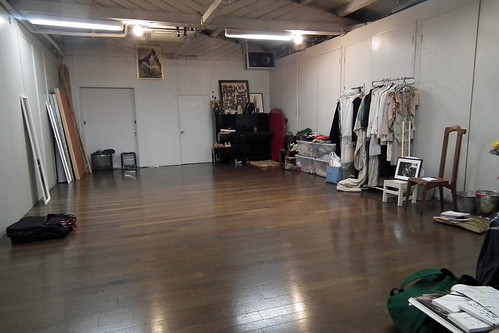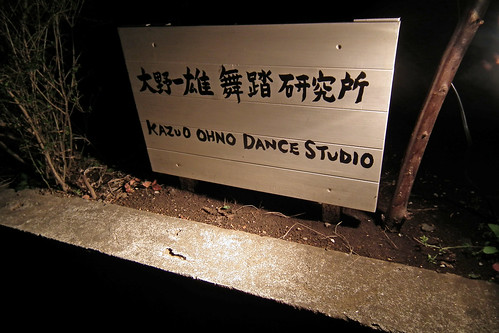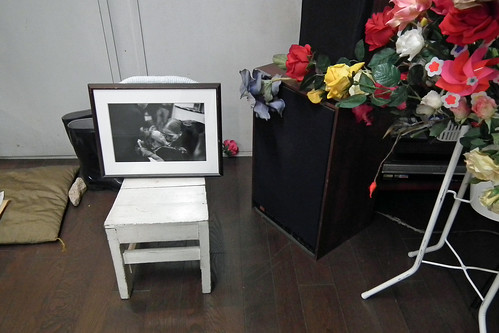The first step is the place, the space: no one can imagine dance without a space.
My dream to visit, step into and and learn at the study of Kazuo Ohno in Yokohama must then begin by a small account of the space.
Kazuo Ohno built his studio, back in the 60's, next to his home on the hills of Kamihoshikawa, part of Yokohama's metropolitan region, less than an hour by train from central Tokyo. It was, and still is, a humble studio, simple but very functional: it has a wooden floor, a piano, several closets, a bathroom, a kitchenette, lounge chairs, a television, a glass cupboard, a sound system, a small illumination system; it's built from wood and metal sheets, with a group of supports that, when it rains, keep the studio from flooding by water running down the hill; outside, there is a shelf for shoes and a basket for umbrellas . From the entrance one can see the dining room and part of the kitchen of Ohno's house, and one feels ashamed to enter into the privacy of the home and prefers to look away.
Getting to the studio is a journey, is not easy, and everyone gets lost their first time, be they foreigners or Japanese - it's not a matter of language. And that's because, being in a hilly area where alleys and labyrinthine stairs are the only ways, one can not find the one alley and stair leading to the studio. For about 35 minutes I went up and down the hill several times, took several stairs, asked passers-by, checked the map a dozen times; exhausted and with so tired my legs were shaking, in the end I decided to take the first alleyway off the road and follow its roundabout path and there, after a turn which was not visible from the main road, the sight of the stairs that would finally lead to the study.
Mid-way up the hill you discover a wooden sign that reads, in Japanese and English, "Kazuo Ohno Dance Studio."
I was finally in front of that sign, a highpoint in my life as a student: I was there after that weary journey to find the place, after a month of uncertainty due to the earthquake in the north of the country and problems at the Fukushima nuclear power plant, after a year of studying and discovering Butoh dance with several teachers in Canada, and after a little more than 20 years after first seeing the figures of Kazuo and Yoshito Ohno on stage, setting their work as an example before all my students, my colleagues and myself. There was I, in front of that sign, and I stood there for several minutes.
It was night already, some wind was blowing lightly, you could hear the trains passing in the distance, you could also hear some crickets, and nothing else.
Before meeting master Yoshito Ohno I got to know the studio, I could see his objects exactly as Kazuo Ohno used them (Yoshito Ohno has respected in full the arrangement of things and nothing has changed place): his chair, his music, his dolls, puppets and masks, his books, his costumes, the shoes of his female characters, his hats, the floor.
As is the usual Japanese (and Eastern) custom, you leave your shoes at the entrance and enter barefoot, that way you can go around the premises with the confidence that you won't damage anything nor will bother anyone the noise of your walking. And so I did, I entered like that, barefoot, and so I stepped where Kazuo and Yoshito stepped and danced together, where sometime they stepped and danced along with Hijikata, where now, by himself, Yoshito Ohno steps and dances, as the heir that is .
I remembered some pantomime class that I had taken in my university years, where for the first time in my life I heard the idea that the workspace was a sacred place, that you should greet it and ask it for permission to enter. I thought of the feet of the teachers, of their bodies falling and rolling, and to those images, as my mother used to say, I "entrusted myself"
In my stepping I checked all of the space and my eyes fell on a picture on a tiny wooden chair: was the moment when Pina Bausch visited an ailing Kazuo and gave him a kiss; a really beautiful photograph, a very hard one, which made me tremble. Strange paradoxes of life, Pina visited the ailing, and perhaps dying Kazuo, but she would die a year before him.
I know some of you, artists or not, understand my dwelling on this first step into the workspace of the studio of master Ohno, my devoting a blog entry to this account of the place where one has dreamed of being and of learning in. I know some of you have dreamed of stepping into a place you really felt was sacred; it is you I'm addressing and for whom I write these texts, I took these photos and this video that illustrates that first step in my visit to the dance studio of master Kazuo Ohno in Yokohama, last April 20th 2011.
Texts, photographs and videos in this Blog are all author's property, except when marked. All rights reserved by Gustavo Thomas.
If you have any interest in using any text, photograph or video from this Blog, for commercial use or not, please contact Gustavo Thomas at gustavothomastheatre@gmail.com.

















